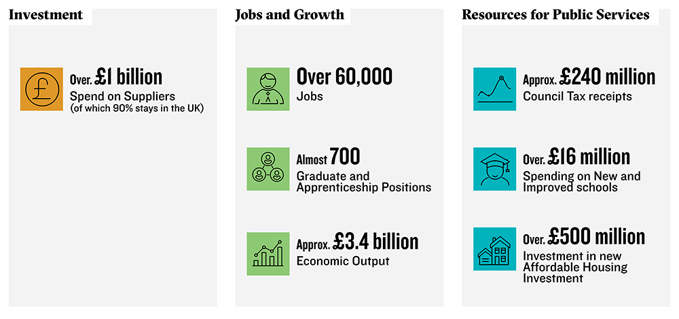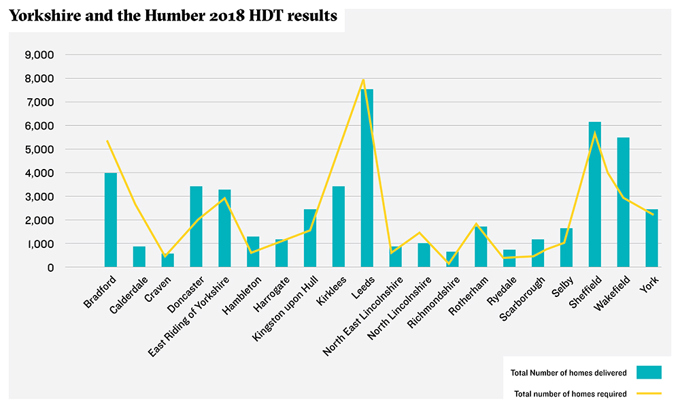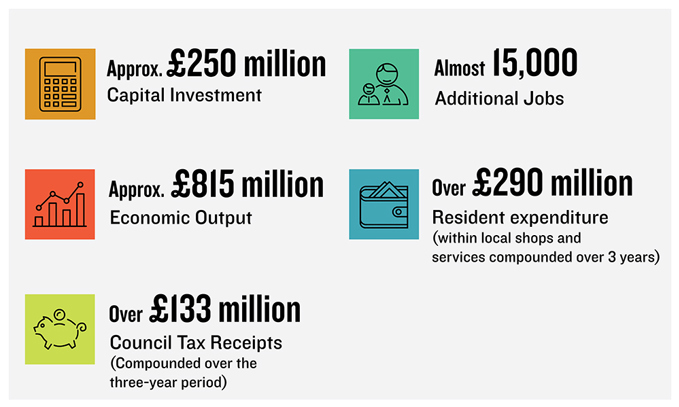The Home Builders Federation (HBF) recently published a series of regional reports highlighting the economic footprint of home building. These reports were based on research carried out by Lichfields at a national level on behalf of the HBF on the economic footprint of home building in England and Wales
[1], which looked at a wide and comprehensive range of economic, social and environmental benefits that house building generates.
For Yorkshire & the Humber, the results clearly demonstrated the huge contribution house building is making to the Yorkshire & the Humber economy
[2]. However, as well as clearly illustrating the importance of house building to Yorkshire & the Humber’s economy, the findings also served to highlight the opportunities missed from failing to meet minimum housing requirements in some local planning authority (“LPA”) areas.
Benefits Delivered
The regional HBF report used the national level analysis provided by Lichfields and applied this to the total number of homes delivered in Yorkshire & the Humber during 2017-18.
This indicated that in Yorkshire & the Humber in 2017-18, house building was responsible for:

According to the 2018 Housing Delivery Test (“HDT”) results
[3], 19,559 new homes were delivered in Yorkshire & the Humber in 2017-18 – generating the significant economic benefits listed above.
However, a number of LPAs in Yorkshire and the Humber did not meet their minimum housing requirement for the monitoring period 2015-16 to 2017-18, and consequently five LPAs were required to produce Action Plans by August of this year. Additionally, four of these five LPAs must apply a 20% to their five year housing land requirements as result of delivering less than 85% of their housing land requirements. The actions being undertaken by these authorities to address the shortfall is perhaps the subject of a separate blog, however it is interesting to consider the benefits that have been missed as a result of this under delivery.
Figure 1 Yorkshire and the Humber 2018 HDT results
Source: MHCLG
Opportunities Missed
The combined shortfall of those Yorkshire and the Humber authorities that have failed the HDT for 2015-16 to 2017-18 amounted to 4,796 homes. Setting aside that these are homes that are desperately required to meet a wide range of housing needs, there is also a clear economic opportunity cost.
Using the same methodology as used by the HBF in its recent publication, we have calculated the economic benefits which have been missed as a result of these authorities failing to meet their housing needs over the past three years.
Had these LPAs met their minimum housing requirements for the period 2015-16 to 2017-18, it would have resulted in:
This high-level analysis clearly demonstrates that failure to meet local housing requirements not only affects those in need of new housing, but also impacts on significantly on the wider economy.
It should be noted that these figures have been derived using the same national level indices as were used to inform the HBF outputs. They do not therefore reflect regional variations in key metrics or the businesses models of individual housebuilders. Lichfields’ Evaluate model offers the functionality to take account of these nuances to provide more detailed, locally-specific economic assessment and potentially demonstrate greater economic outputs.
Wider Benefits
Of course, the benefits of home building are not purely economic. In additional to playing a vital role in supporting the economy, the home building industry generates a number of social benefits, including supporting positive health and educational outcomes, employment and training opportunities for young people, independent living and regeneration.
Research undertaken by Lichfields on behalf of Homes for Scotland
[4] demonstrated the benefits that new home building can have on people’s health and on improving educational attainment and skills.
A report from the Department of Health has previously suggested that it costs the NHS across the UK £859 million a year to treat illnesses caused by cold private housing
[5]. The delivery of new homes can play a significant role in addressing health issues associated within inadequate housing by providing homes which are well insulated, energy efficient and are designed to protect against damp, cold conditions.
Additionally, research by Shelter has shown that the quality of a child’s housing – in isolation of other factors – has a direct link to educational attainment, likelihood of unemployment and poverty
[6]. The delivery of new housing is therefore central to achieving improvements in childhood health and educational attainment, and failure to meet minimum housing requirements could impact young people’s life chances in terms of educational development.
How Lichfields can help
Lichfields’ Evaluate framework strengthens the economic justification for a development strategy or individual project by considering the full range of local benefits – including economic and social impacts. Evaluate is now regularly used by many of the UK’s leading developers, investors and house-builders to measure the economic benefits of their development and infrastructure proposals across a range of sectors and to communicate these to local and national audiences.
The clear presentation of economic and social benefits arising from housing development can provide robust justification for a proposal and act as a persuasive platform to encourage positive engagement and decision making. In the Yorkshire and Humber region, Lichfields is presently preparing an Economic Benefits Assessment of the East Leeds Extension on behalf of a consortium of house builders.
In addition to location or development specific assessments, Lichfields has an expanding track record in undertaking development industry or group-wide Economic Footprint assessments to measure the economic impact of corporate activities, such as was undertaken on behalf of the HBF. Similar exercises have been produced for Homes for Scotland and a number of major volume house builders, measuring an organisation’s socio-economic footprint across indicators such as employment, economic output, supply chain expenditure, local community financial benefits, tax revenue and development of social infrastructure.
Whilst housing delivery is now being monitored with greater consistency through the HDT, it is important to recognise the wider socio-economic benefits which house building generates, and also recognise the socio-economic opportunities which are missed though failing to meet local housing need.
[1] The Economic Footprint of House Building in England and Wales [2] Yorkshire & The Humber economic footprint of Home Building[3] HDT_2018_measurments[4] The Economic and Social Benefits of Home Building in Scotland[5] Department of Health, (2009), Annual Report of Chief Medical Officers Report[6] https://england.shelter.org.uk/__data/assets/ pdf_file/0016/39202/Chance_of_a_Lifetime.pdf







